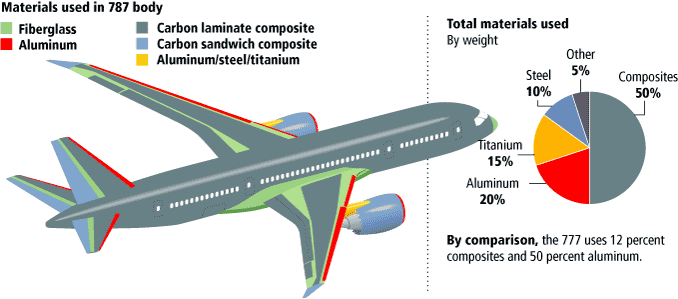Newsletter | Vol 11 - October 2019
Composites
Composites have been present in many forms since the beginning of time. Bone is a natural composite of a collagen matrix with hydroxyapatite particles imbedded, while wood is a lignin matrix with cellulose fibers. It has just been within the past 40 years that modern composite materials have been used in aerospace and aviation applications.
There are basically two types of composite materials: fibers and particulates, which are much like metal alloys. The particulate composites have micron-sized particles imbedded in the matrix. Some of those materials include SiC, Al2O3, Si3N4. These composites are isotropic in nature, meaning that their properties such as strength and stiffness do not vary with the direction of testing. Fiber composites (sometimes called whisker-reinforced composites) are anisotropic, meaning their properties vary depending on the direction of the load with respect to the orientation of the fibers in the composite. To overcome this problem, the layers are often stacked at varying angles to produce a laminate. Carbon fiber-reinforced polymers (CFRP) are used extensively in newer commercial passenger jets like the Boeing 777X, Boeing 787 and Airbus A350.
Composites provide a useful way to reduce weight in structures of importance in aerospace applications, while maintaining strength. Composite structures also have improved stiffness, fatigue performance and corrosion resistance versus metallic structures. They also can be shaped into more complex forms than most metals which eliminates the need for fasteners and their corresponding holes which are sources of stress and cracking.
The percentage by weight of the fighter aircraft F/A 18C/D and commercial jets are shown in the table below:
Percent of Structural Weight |
|||
Component material |
F/A 18C/D |
Boeing 787 |
Boeing 737 |
Aluminum |
49 |
20 |
75 |
Steel |
15 |
10 |
7 |
Titanium |
13 |
15 |
3 |
Carbon Epoxy |
10 |
50 |
12 |
Other |
13 |
5 |
3 |
|
|
|
|
Total |
100 |
100 |
100 |
CFRPs are used in wing, empennage and fuselage applications. In the B-2 stealth aircraft, radar-absorbing materials had to be added to the outside of the plane at some increase in weight. The use of composites elsewhere compensated for this weight gain. See the pictorial representation of the materials used to construct the Boeing 787 Dreamliner.

In commercial aircraft, the obvious case for composites is the reduced weight which allows for better fuel economy, but also lower maintenance, longer times before major inspections and lower operational costs. The cost of composites is higher versus metallic structures. Newer twin aisle planes like the Boeing 787 and Airbus A350 use extensive composites, but the single aisle planes (Boeing 737 and Airbus A320) remain mostly metallic because of cost.
CINDAS LLC has frequently been asked to assemble a composites database. Because there are so many possible variations in components for composites, we have been deliberate in constructing the composites database. In early 2020, we will be introducing the CINDAS Composite Materials Database (CCMD) which will contain 520 materials (both whisker- and particulate-reinforced), in 7 material groups. There are 12 property groups, with 202 properties. The total number of data sets is 4,430 with approximately 12,000 data curves.
This database was carefully developed from various published and previously unpublished CINDAS LLC sources including the Databook on Mechanical and Thermophysical Properties of Whisker-Reinforced Ceramic Matrix Composites and the Databook on Mechanical and Thermophysical Properties of Particulate-Reinforced Ceramic Matrix Composites published by the Ceramics Information Analysis Center at Purdue University. Having all information from various CINDAS LLC databases as well as that of newly developed materials in a single source will be a great advantage to users.
If you are interested in previewing this new product, please contact Patricia Mason at patti@cindasdata.com.
"Information is the oil of the 21st century, and analytics is the combustion engine." -- Peter Sondergaard










